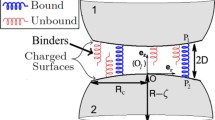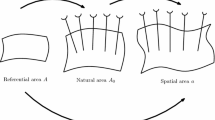Abstract
We present a unified, multiscale model to study the attachment/detachment dynamics of two deforming, charged, near spherical cells, coated with binding ligands and subject to a slow, homogeneous shear flow in a viscous, ionic fluid medium. The binding ligands on the surface of the cells experience both attractive and repulsive forces in an ionic medium and exhibit finite resistance to rotation via bond tilting. The microscale drag forces and couples describing the fluid flow inside the small separation gap between the cells, are calculated using a combination of methods in lubrication theory and previously published numerical results. For a selected range of material and fluid parameters, a hysteretic transition of the sticking probability curves (i.e., the function \(g^*\)) between the adhesion phase (when \(g^*>0.5\)) and the fragmentation phase (when \(g^*<0.5\)) is attributed to a nonlinear relation between the total nanoscale binding forces and the separation gap between the cells. We show that adhesion is favoured in highly ionic fluids, increased deformability of the cells, elastic binders and a higher fluid shear rate (until a critical threshold value of shear rate is reached). Within a selected range of critical shear rates, the continuation of the limit points (i.e., the turning points where the slope of \(g^*\) changes sign) predict a bistable region, indicating an abrupt switching between the adhesion and the fragmentation regimes. Although, bistability in the adhesion-fragmentation phase diagram of two deformable, charged cells immersed in an ionic aqueous environment has been identified by some in vitro experiments, but until now, has not been quantified theoretically.






Similar content being viewed by others
References
Bäbler MU, Morbidelli M (2007) Analysis of the aggregation-fragmentation population balance equation with application to coagulation. J Colloid Interface Sci 316(2):428–441
Bihr T, Seifert U, Smith AS (2012) Nucleation of ligand-receptor domains in membrane adhesion. Phys Rev Lett 109(25):1–5
Brunk DK, Hammer DA (1997) Quantifying rolling adhesion with a cell-free assay: E-selectin and its carbohydrate ligands. Biophys J 72(6):2820–2833
Coombs D, Dembo M, Wofsy C, Goldstein B (2004) Equilibrium thermodynamics of cell-cell adhesion mediated by multiple ligand-receptor pairs. Biophys J 86(3):1408–1423
Corezzi S, Fioretto D, Sciortino F (2012) Chemical and physical aggregation of small-functionality particles. Soft Matter 8(44):11207–11216
Cox R, Brenner H (1967) The slow motion of a sphere through a viscous fluid towards a plane surface. Part II. Small gap widths, including inertial effects. Chem Eng Sci 22:1753–1777
Davis RH, Schonberg JA, Rallison JM (1989) The lubrication force between two viscous drops. Phys Fluids 1:77–81
Davis RH, Zinchenko AZ (2009) Motion of deformable drops through granular media and other confined geometries. J Colloid Interface Sci 334(2):113–123
Dembo M, Torney DC, Saxman K, Hammer D (1988) The reaction-limited kinetics of membrane-to-surface adhesion and detachment. Proc R Soc Lond Ser B 234(1274):55–83
Duval JFL, Pinheiro JP, Van Leeuwen HP (2008) Metal speciation dynamics in monodisperse soft colloidal ligand suspensions. J Phys Chem A 112(31):7137–7151
Forest MG, Sircar S, Wang Q, Zhou R (2006) Monodomain dynamics for rigid rod and platelet suspensions in strongly coupled coplanar linear flow and magnetic fields. II. Kinetic theory. Phys Fluids 18(10):103102 1–14
Gilbert B, Lu G, Kim CS (2007) Stable cluster formation in aqueous suspensions of iron oxyhydroxide nanoparticles. J Colloid Interface Sci 313(1):152–159
Gregory J (2006) Particles in water: properties and processes. CRC Press, Boca Raton
Haber S, Hetsroni G, Solan A (1973) On the low reynolds number motion of two droplets. Int J Multiph Flow 1(1):57–71
Hammer DA, Tirrell M (1996) Biological adhesion at interfaces. Ann Rev Mater Sci 26(1):651–691
Hodges SR, Jensen OE (2002) Spreading and peeling dynamics in a model of cell adhesion. J Fluid Mech 460:381–409
Jadhav S, Eggleton CD, Konstantopoulos K (2005) A 3-D computational model predicts that cell deformation affects selectin-mediated leukocyte rolling. Biophys J 88(1):96–104
Jadhav S, Eggleton CD, Konstantopoulos K (2007) Mathematical modeling of cell adhesion in shear flow: application to targeted drug delivery in inflammation and cancer metastasis. Curr Pharm Des 13(15):1511–1526
Jia Z, Gauer C, Wu H, Morbidelli M, Chittofrati A, Apostolo M (2006) A generalized model for the stability of polymer colloids. J Colloid Interface Sci 302(1):187–202
Jones DA, Smith CW, McIntire LV (1996) Leukocyte adhesion under flow conditions: principles important in tissue engineering. Biomaterials 17(3):337–347
Kim S, Karrila SJ (2005) Microhydrodynamics: principles and selected applications. Dover Publications, New York
King MR, Sumagin R, Green CE, Simon SI (2005) Rolling dynamics of a neutrophil with redistributed L-selectin. Math Biosci 194(1):71–79
Korn C, Schwarz US (2006) Efficiency of initiating cell adhesion in hydrodynamic flow. Phys Rev Lett 97(13):1–4
Lauffenburger DA, Linderman JJ (1993) Receptors: models for binding, trafficking and signalling. Oxford University Press, New York
Mani M, Gopinath A, Mahadevan L (2012) How things get stuck: kinetics, elastohydrodynamics, and soft adhesion. Phys Rev Lett 108(22):226104–226108
Marshall BT, Long M, Piper JW, Yago T, McEver RP, Zhu C (2003) Direct observation of catch bonds involving cell-adhesion molecules. Nature 423(6936):190–193
Moncho-Jordá A, Odriozola G, Martínez-López F, Schmitt A, Hidalgo-Álvarez R (2001) The DLCA-RLCA transition arising in 2D-aggregation: simulations and mean field theory. Eur Phys J E 5(4):471–480
Moss MA, Anderson KW (2000) Adhesion of cancer cells to endothelial monolayers: a study of initial attachment versus firm adhesion. J Adhes 74:19–40
Odriozola G, Moncho-Jordá A, Schmitt A, Callejas-Fernández J, Martínez-García R, Hidalgo-Álvarez R (2007) A probabilistic aggregation kernel for the computer-simulated transition from DLCA to RLCA. Europhys Lett 53(6):797–803
O’Neill ME, Majumdar SR (1970) Asymmetrical slow viscous fluid motions caused by the translation or rotation of two spheres. Part II: asymptotic forms of the solutions when the minimum clearance between the spheres approaches zero. Zeitschrift angewandte Mathematik und Physik ZAMP 21(2):180–187
Reboux S (2008) Multiscale models for cellular adhesion and deformation. PhD thesis, University of Nottingham
Reboux S, Richardson G, Jensen OE (2008) Bond tilting and sliding friction in a model of cell adhesion. Proc R Soc A Math Phys Eng Sci 464(2090):447–467
Shao JY, Ting-Beall HP, Hochmuth RM (1998) Static and dynamic lengths of neutrophil microvilli. Proc Natl Acad Sci 95(12):6797–6802
Sircar S, Bortz DM (2013) Impact of flow on ligand-mediated bacterial flocculation. Math Biosci 245(2):314–321
Somasundaran P, Runkanan V, Kapur P, Stechemesser H, Dobiáš B (2005) Flocculation and dispersion of collodial suspensions by polymers and surfactants: experimental and modeling studies. Coagul Flocculation 126:767–803
Springer TA (1995) Traffic signals on endothelium for lymphocyte recirculation and leukocyte emigration. Ann Rev Phys 57(1):827–872
Varenberg M, Gorb S (2007) Shearing of fibrillar adhesive microstructure: friction and shear-related changes in pull-off force. J R Soc Interface R S 4(15):721–725
Yago T (2002) Distinct molecular and cellular contributions to stabilizing selectin-mediated rolling under flow. J Cell Biol 158(4):787–799
Zhu C (2000) Kinetics and mechanics of cell adhesion. J Biomech 33(1):23–33
Acknowledgments
Authors thank Dr. Edward Green in the Department of Mathematical Sciences, Adelaide University, for providing useful insights at later stages of the model development. We are also grateful for the two anonymous reviewers providing their detailed criticism which has helped improve the clarity of this article.
Author information
Authors and Affiliations
Corresponding author
Additional information
S. Sircar is supported by the Adelaide University startup funds and AJR is supported by the Australian Research Council Discovery grant DP150102385.
Rights and permissions
About this article
Cite this article
Sircar, S., Roberts, A.J. Surface deformation and shear flow in ligand mediated cell adhesion. J. Math. Biol. 73, 1035–1052 (2016). https://doi.org/10.1007/s00285-016-0983-7
Received:
Revised:
Published:
Issue Date:
DOI: https://doi.org/10.1007/s00285-016-0983-7




